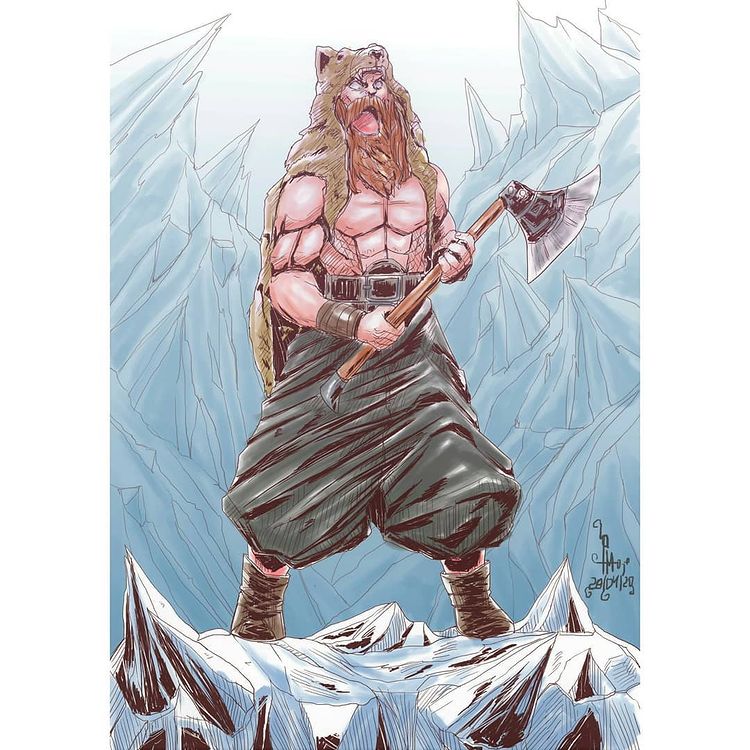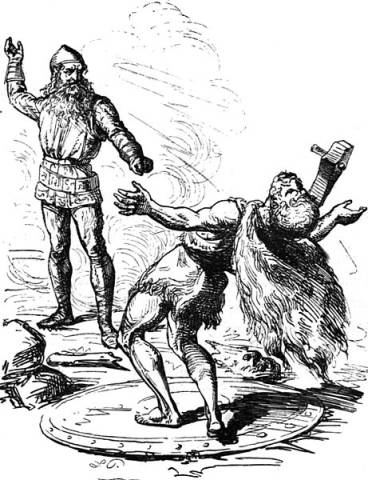In Norse mythology Magni is the god og brute strength, more than anything else. Clearly he is taking after his father Thor and his sister Thrud. Already as a three day old, Magni saved his father when he was trapped under the body of the stone giant Hrungnir. Proving to be stronger than any of the other gods.
When writing about Magni I also want to point out that while he is clearly an Aesir god, he is in fact 3/4 jötun. His father Thor, is half jötun, and his mother Járnsaxa is a jötun. This do prove my own thoughts that which tribe you identified with was much more important than your actual blood relation. This probably mirrored Viking Age society to some degree, where adoptions were common, and belonging to a clan had to be important.
Magni Key Facts
| Parents | Thor and Járnsaxa |
| Partners | None known |
| Siblings | Modi, Thrud |
| Offspring | None known |
| Tribe | Aesir |
| Old Norse name | Magni |
| Other names | None known |
| The God of | Strength |
Name and Etymology
Magni’s name in Old Norse language translates to “strong” or “mighty.” This etymological origin is a testament to the essence of his character, representing unparalleled strength and valor in the Norse pantheon. Kennings, which are poetic metaphors used in Old Norse literature, further amplify the significance of his name. While there aren’t many kennings directly associated with Magni, references to “Thor’s mighty son” or “strength’s embodiment” in various sagas and poems allude to his legendary might.
Magni Origins
Magni’s origins are deeply woven into the intricate fabric of Norse mythology, a realm where gods, giants, and mortals often intersect. Born to Thor, the god of thunder, and Járnsaxa, a jötun, Magni’s lineage is a testament to the complex relationships that exist between the Aesir gods and the giants. He is hardly alone in being part god, part jötun. I haven’t made a list, but it is quite common. .

Thor, renowned for his might and valor, had other children as well. With his wife, Sif, he fathered Modi and Thrud, a goddess with also known for her strength. Both Modi and Thrud are Magni’s half-siblings, sharing the same father but born of different mothers. This intricate family tree underscores the multifaceted relationships and alliances that are a hallmark of Norse tales. Again, I do think that these familial bonds mirrored Viking Age society, more than we might understand today.
As for Magni’s birth, we don’t know anything about the circumstances. Thor was often traveling the different realms though, and apparently met with Járnsaxa at some point. Being the offspring of a powerful god and a strong jötun, Magni’s birth symbolizes a union of two potent forces. This blend of divine and giant heritage obviously granted him immense strength.
Magni’s Relationships and Children
In the realm of Norse mythology, where gods often have intricate romantic entanglements and numerous offspring, Magni has no such storeis. Despite being a figure of great strength and significance, there’s no mention in the sagas of Magni having a wife or a love interest. This absence of romantic ties is less usual, especially when considering the extensive family trees of some other Norse gods.
Furthermore, the tales are silent about Magni fathering any children. Many gods in Norse mythology have legitimate or illegitimate descendants, or even both, who carry forward their legacy, Magni’s stories focus solely on his deeds and adventures, without delving into potential offspring.
You might think that he just didn’t have anyone, or as I believe, the reason is simply that we no longer have the text, or knowledge about him. Sadly, lots of ancient books and manuscripts have been lost, and I think Magnis’ story was likely found in them.
Depiction And Role
Magni’s appearance, much like his father Thor, is often depicted as that of a robust and formidable warrior. Symbols associated with him are scarce, but his mere presence in tales often symbolizes unmatched strength and resilience. As for his personality, Magni is brave, loyal, and honorable. His actions in myths, especially his unwavering support for his father, showcase a god who is both fierce in battle and compassionate in victory.
Roles And Responsibilities
As the god of strength, Magni’s primary role in the pantheon is to embody and showcase unparalleled might. While he doesn’t govern over realms or have specific duties like some other gods, his presence is a constant reminder of the Aesir’s power and resilience. In battles and conflicts, Magni’s strength often turns the tide, making him an invaluable ally to the gods.
Play Fun Norse Quiz
Is this article making you even more curious about Norse gods and goddesses? You can satisfy your curiosity by playing a fun Norse mythology quiz. This way, you can test your knowledge about Norse gods and goddesses, as well as fill in some gaps. Good luck and have fun playing!
Don’t forget to try our other games as well!
Myths about Magni
Magni’s tales, though not as numerous as some other gods, are nonetheless impactful. For one, he saves his father, and secondly, he will survive Ragnarök. Without him and the other survivors, you and I wouldn’t be here.
Saving Thor
In the vast landscape of Norse mythology, a particular tale stands out, highlighting Magni’s unparalleled strength at a remarkably young age. After a fierce battle between Thor and the giant Hrungnir, Thor emerged victorious but found himself trapped beneath the massive leg of the defeated giant. The gods, witnessing this predicament, tried in vain to free Thor, their efforts proving fruitless against the immense weight.

Then, in a moment that would become legendary, Magni, who was astonishingly only three days old, stepped forward. With a display of might that left even the gods in awe, he lifted Hrungnir’s leg, rescuing his father. As a token of gratitude, Thor gifted his young son with Goldfaxi, a swift horse that had once belonged to Hrungnir.
Magni’s Role in Ragnarok
Ragnarok, the cataclysmic event prophesied to bring about the end of the world, saw the fall of many gods and the reshaping of the cosmos. Amidst the chaos, destruction, and sorrow, a glimmer of hope emerged. Magni, alongside his half-brother Modi and a few other figures, survived the apocalypse. While many gods met their fates in devastating confrontations, their survival was symbolic of the resilience and enduring spirit of the Aesir.
As the dust settled and a new world began to take shape, these survivors, including Magni and Modi, stood as beacons of hope. Inheriting their father’s legendary hammer, Mjölnir, they carried forth Thor’s legacy, symbolizing a new beginning and the promise of renewal in the post-Ragnarok world.
Magni In Old Norse Religion
Worship of Magni wasn’t as widespread as that of Odin or Thor. This is the same for many of the slightly peripheral gods in the Norse pantheon. However, he was likely seen and revered as a symbol of strength and resilience. His tales were likely invoked to inspire courage and determination in the face of overwhelming odds.
Mentions in Ancient Texts
Norse mythology, rich in legends and lore, has been immortalized through ancient texts. These writings provide invaluable insights into the tales and beliefs of the Norse people. Among them, the stories of Magni stand out, offering glimpses into his valor and significance.
Poetic Edda – Vafþrúðnismál
The Poetic Edda, an ancient collection of Old Norse poems dating back to the 13th century, offers a glimpse into the roles and fates of various Norse gods, including Magni. One of its poems, Vafþrúðnismál, specifically mentions Magni and his brother Modi as survivors of Ragnarök. The authorship of the Poetic Edda remains anonymous, but it’s a crucial source for understanding Norse mythology and its intricate tales.
51. Vafthruthnir spoke:
“In the gods’ home Vidar | and Vali shall live,
When the fires of Surt have resided;
Modi and Magni | will have Mjollnir
After Thor falls in battle.”
Prose Edda – Skáldskaparmál
The Prose Edda, another seminal work on Norse mythology, was penned by the historian and politician Snorri Sturluson in the 13th century. In the book Skáldskaparmál, a section of the Prose Edda, there are a couple of mentions of Magni.
First in chapter IV – On how to paraphrase Thor, he is mentioned as Thor’s son.
Sung This Way By Eilífr:
Wroth stood Röskva’s Brother,
And Magni’s Sire wrought bravely:
With terror Thor’s staunch heart-stone
Trembled not, nor Thjálfi’s.
Magni’s role in Thor’s battle with the giant Hrungnir is also elaborated. Thor kills Hrungnir, but lies trapped and unconscious under the giant’s leg. From chapter 17, paragraph 18 we can read how Magni comes to his fathers aid.
“Then Magni came, son of Thor and Járnsaxa: he was then three nights old. He threw Hrungnir’s foot off Thor, and spoke: ‘See how bad it is, father, that I came so late: I had struck this giant dead with my fist, I think, if I had met with him.”
As a token of his gratitude, and to the dismay of Odin, Thor gifts Magni the dead giant’s horse, Gullfaxi.”‘And I will give thee,’ he said, ‘the horse Gold-Mane, which Hrungnir possessed.’ Then Odin spake and said that Thor did wrong to give the good horse to the son of a giantess, and not to his father.”
I find that the irony is thick, as Odin is himself the son of a jötun woman, Bestla, and Thor is as well. Again, I think that the lines between the gods and the jotnar sometimes were remarkably fluid.
FAQs
Magni’s name translates to “strong” or “mighty” in Old Norse.
He is the son of Thor, the god of thunder, and Járnsaxa, a giantess.
No, Magni doesn’t have a specific animal associated with him.
Magni embodies unparalleled strength and might among the Aesir.
There aren’t specific festivals for Magni, but his tales inspire strength and resilience.
Magni’s stories are primarily detailed in the Poetic Edda and the Prose Edda.
